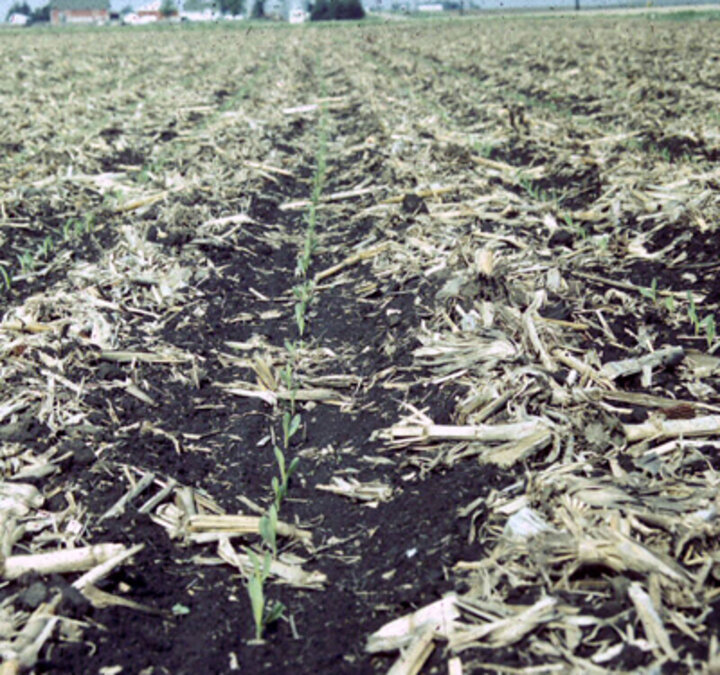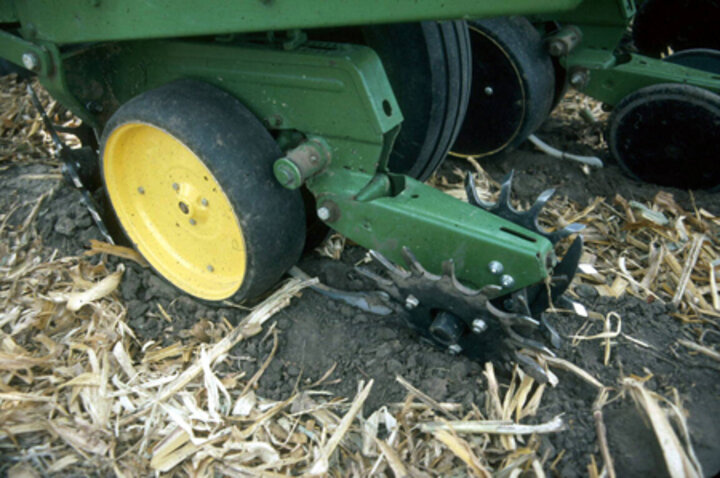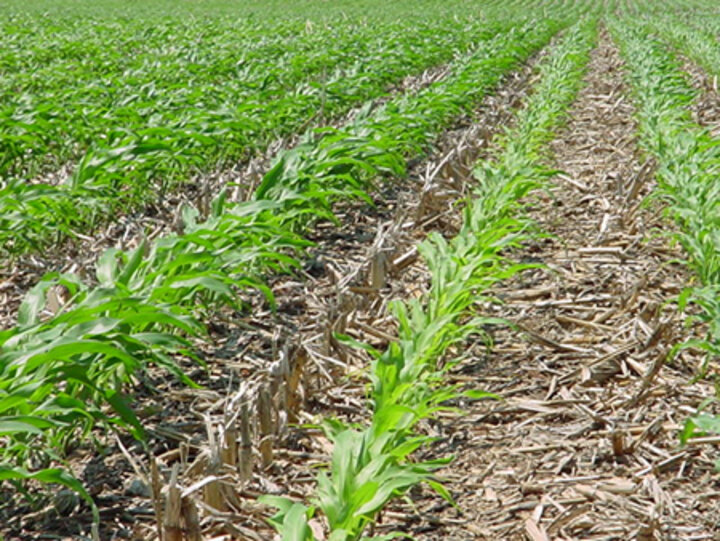April 13, 2007

Producers are planting more corn on corn, hoping to take advantage of the ethanol boom. They are using no-till production systems to improve their soil while conserving water. Without crop rotation, however, no-till corn on corn can be challenging, if not properly managed, especially with the increased residue levels. Rather than give up the benefits of no-till, producers can improve their management to make no-till corn on corn less risky. These planting considerations should help make no-till corn on corn more successful. Following is the seventh in a series of CropWatch articles on critical points to consider and recommendations for making no-till corn on corn more successful.
- Maintain sharp openers. Double-disk seed furrow openers, if sharp and adjusted properly, can cut through residue better than coulters. The disks should be in good condition and working together as one cutting edge to cut the residue and open the seed-vee. (See Setting planting equipment for successful no-till in the April 14, 2006 issue of CropWatch.)
- Avoid coulters. Coulters can be used to cut residue, loosen the soil, and take some wear and tear away from the seed furrow openers in abrasive soils; however, the tillage they perform may cause air pockets in the seed zone when operated too deep and may overdry the seed zone. If the soil is wet and sticky, the soil disturbed by coulters tends to stick to the depth gauge wheels, affecting planting depth. If the soil is dry and loose, coulters may hairpin residue, rather than cut it. In these conditions, double disk openers will usually do a better job of cutting residue because they are sharper than coulters and have a slight tearing action as the disks separate. When used, coulters should be set about a quarter inch shallower than planting depth so that the seed furrow opener makes the bottom of the seed-vee. Some companies are moving the coulter a couple of inches to the side of the row to reduce disturbance of the seed zone while providing cutting of the residue so that residue movers can part the residue more effectively.
- Don't hairpin residue. If hairpinning is a problem, plant deeper as the cutting angle of the leading edge of a double-disk opener or a coulter is directly related to the operating depth. The common 15-inch diameter disk opener cuts residue the best when operated about 2 to 3 inches deep. Planting shallower results in hairpinning as the openers are pushing downward on the residue rather than cutting it while moving forward. Sharp cutting edges are a must.
- Do you need residue movers? Consider spoked residue movers on the planter to warm poorly drained soils by parting the residue or to "even up" the residue. If some of the row has residue cover and some does not, emergence will not be very uniform as there will be differences in soil moisture and soil temperature. Spoked residue movers can remove the thicker layers of residue to make the surface more uniform, but care should be taken not to move any soil. Floating residue movers with depth bands help keep the surface more uniform, reducing soil movement. However, if the residue cover is already uniform, such as in long-term no-till, residue movers can do more harm than good. In these cases, residue which is detached and moved out of the row at planting time may later blow or wash back over the row. This makes the surface less uniform resulting in less uniform emergence. Emerging corn may leaf out under the residue, again making the stands less uniform.
- Plant at the proper depth. Too often, producers plant corn too shallow in no-till, thinking that they are placing the seed in a warmer environment for quicker emergence. While planting deeper does put the seeds in slightly cooler soil, the soil temperature is more uniform and buffered more from low night time temperatures, resulting in more uniform emergence. (Use a pop-up starter if cool soils are a concern.) Corn will develop a better root system when planted 2 to 3 inches deep, especially when the soil surface is dry. When corn is planted too shallow, rootless corn syndrome may develop as the nodal roots cannot form properly. Also, brace root formation is affected if planting depth is too shallow and lodging may be a problem later in the season.
- Penetrate the soil to the desired planting depth. The heavier residue of no-till corn on corn requires heavy-duty downpressure springs and extra weight on the planting units to cut through the residue and penetrate the soil to the desired seeding depth. Remember to set the planting depth slightly deeper as the depth gauge wheels will be riding on some residue. Check the planting depth as planting conditions change, especially as the soil drys out later in the planting season and more downpressure is needed. (See Preseason field check of planting equipment in the April 14, 2006 issue of CropWatch to learn how to check downpressure springs and weight.)
- Plant into a good seeding environment. For corn on corn, plant about 4 or 5 inches off to the side of the old row to reduce bouncing over the old root stumps. The depth control and seed-to-soil contact will be much more uniform than planting down the old rows. Avoid planting in the heart of the wheel tracks between the old rows as that is the most compacted area of the field. When planting between rows, it's more difficult to set a planter for uniform seed placement and emergence as the other rows will be planted into non-trafficked row middles. Also, planting between the rows increases tire wear since you will be driving on the old rows.
- Maintain a uniform seeding depth. Use Keeton Seed Firmers or Schaffert Rebounders to get all the seeds to the bottom of the seed-vee for more uniform emergence. (Both have options for putting a pop-up fertilizer in the furrow for quicker early growth.) In dry conditions, the Keetons do provide seed firming compared to the Schafferts, but may build up with soil in wet conditions. The Schafferts don't drag the seed in the furrow as they are run above the bottom of the seed-vee, getting the seeds to the bottom of the furrow. The low profile or shortened Keeton Seed Firmers reduce seed dragging and soil buildup in wet conditions while providing seed firming.
-

Spoked closing wheels till the seed-vee closed and help dry the soil. A Keeton Seed Firmer was added to provide seed-to-soil contact when the standard press wheels were removed. Adding a drag chain behind the closing wheels would smooth the soil surface and make this row unit similar to the "Martin-Till" system. Properly close the seed-vee. Standard closing wheel systems should be set to close the seed-vee and provide seed-to-soil contact without overpacking the seed-vee. Sidewall compaction is typically caused when the closing wheels overpack the seed-vee in wet conditions. (See Avoiding Sidewall Compaction at Planting — Don't Plant Too Shallow, in the April 20, 2007 edition of CropWatch). Consider spoked closing wheels on the planter, or one spoked wheel and one standard wheel, to till in the seed-vee in wet conditions, reducing the chances of the seed-vee opening back up as the soil drys. However, this tillage tends to dry the soil while closing seed-vee and some spoked wheels may not provide good seed-to-soil contact. If the closing wheels can be staggered, one in front of the other, doing so will help close the seed-vee in heavier soils.
- Maintain proper planting speeds. Plant at 4 to 5 mph to reduce planter unit bounce and place the seeds uniformly. While manufacturers may claim that they can meter the seeds and have good seed singulation at higher planting speeds, planters are typically designed to deliver the seeds to the furrow at about 5 mph. At higher speeds, seeding depth and seed-to-soil contact are less uniform, resulting in seeds being in different moisture and temperature conditions. With varying depths and improper firming, some of the soil around the seeds may dry out quickly, resulting in less uniform emergence.
- Consider planter attachments rather than tillage to dry wet soils. The "Nu-Till", "Martin-Till", and some other planting systems use "tillage" on the planter to dry out wet soils. Attachments on the planter place nitrogen fertilizer, move residue, firm the seed into wet soils, apply a pop-up starter, and till the seed-vee closed, all in one trip. A single disk fertilizer opener cuts the residue while applying nitrogen about 4 inches to the side of the row. The spoked residue movers can easily part the already cut residue. Spoked closing wheels till the sidewalls of the seed-vee to close the furrow and dry the soil around the seed so that it warms up quicker. A flat-linked or twisted-link drag chain pulls soil back over the furrow to smooth the row. By drying the soil and placing the nutrients, many of the concerns of planting into heavy residues are reduced. However, in well drained soils and in dry years, this tillage may dry the soil too much. In wet sticky soils, this tillage may create problems with mudding up the planter. Care must be taken when setting up and adjusting the planter to make these systems successful, yet they add flexibility because adjustments can be made as conditions change.
Paul Jasa
Extension Engineer

